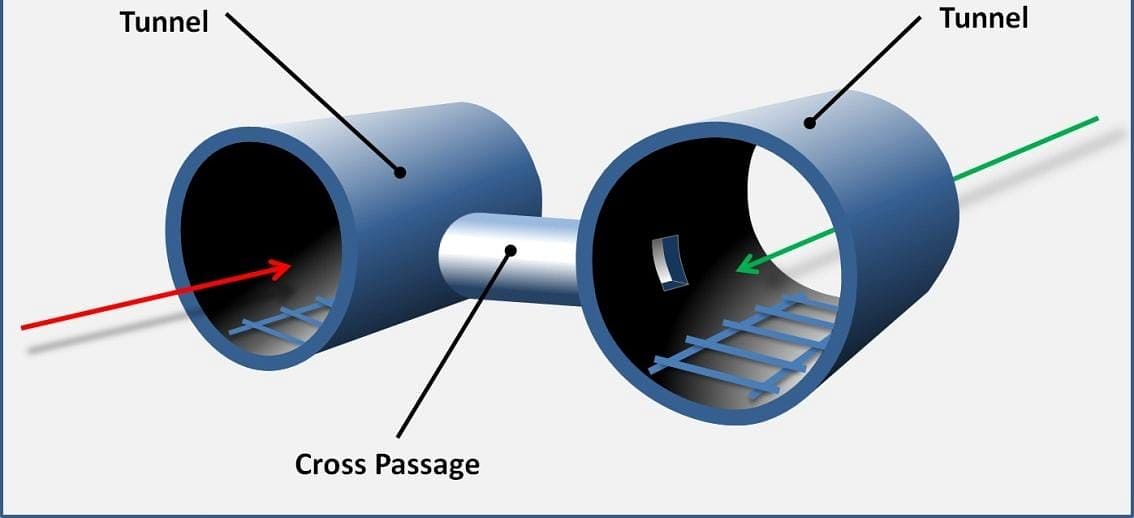The cross passages are helpful in the operation of trains and the safety of passengers in case of emergency in the underground section.
A total of nine cross passages in the Meerut section, and 12 cross passages in the Delhi section will be constructed.
Cross passages are being constructed to connect the parallel tunnels of the underground section of Delhi-Ghaziabad-Meerut RRTS corridor.
These cross passages are being constructed based on the New Australian Tunneling Method (NATM) technology.
In the underground portion of the Regional Rapid Transit System (RRTS) corridor, two parallel tunnels are being constructed for the movement of trains on each route. Provision of one cross passage has been made in these tunnels at a distance of every 250 metres.
Cross-passage is a part between the two tunnels which enables movement of people from one tunnel to another in case of necessity or emergency. These cross passages are helpful in the operation of trains and the safety of passengers in case of emergency in the underground section.
In case of an emergency, if train operations in one tunnel stop due to any unforeseen reasons, then through these cross passages, commuters can be evacuated from the other tunnel.
For the construction of the cross-passage by NATM technique, a sequential excavation method is adopted. First, an inner line is drawn on the soil with the help of steel plate, girder and wire mesh — the area where the excavation has to be made for the cross-passage is marked.
Then, the soil is excavated with the help of small machines operated by hand. Rock bolts are used to stabilize the soil. During this construction process, the soil pressure and its effect on the surface are continuously checked through instruments.
With the construction of the cross passage, it is reinforced with concrete, then tunnel rings are installed to give it more strength and stability. The NATM method is effective for tunnel construction or cross passage in small and curved places.

A total of six tunnels are being constructed in Meerut, on the Delhi-Ghaziabad-Meerut corridor, in which a total of nine cross-passages will be constructed.
A total of six cross passages in 2-km-long parallel tunnels between Bhainsali to Meerut Central, a total of two cross passages in 1-km-long parallel tunnels between Bhainsali to Begumpul and one cross-passage between about 700-m-long parallel tunnels between Gandhi Bagh to Begumpul, are being constructed.
On the other hand, a total of four tunnels are to be constructed on the RRTS corridor in Delhi, in which a total of 12 cross-passages will be constructed.
A total of eight cross-passages will be constructed in both the 3-km-long parallel tunnels under construction, between New Ashok Nagar to Anand Vihar and a total of four cross-passages will be constructed in the 2-km-long parallel tunnels under construction, between Anand Vihar to Sahibabad.
It may be noted that about 90 meters long Sudarshan tunnel boring machine (TBM) is being used for tunneling in the RRTS project.
The Sudarshan moves forward by cutting the soil and installing the tunnel rings. In this way, the tunnel construction keeps progressing as it moves forward. Tunneling with the help of a TBM is one of the most advanced techniques.
For the first time in any urban mass transit project in India, tunnel of a 6.5 m diameter is being constructed. Provisions of various security measures have also been made to ensure the safety of the passengers in the underground portion.
The construction of the cross passage is one such provision. Apart from this, ventilation ducts are being constructed to ensure the air circulation in the RRTS tunnel.
Also, a side walkway of 60-90 cm wide is being constructed in the tunnels, which will not only assist in maintenance activities but will also help in case of emergencies.
The RRTS project is being implemented as per the stipulated time frame.
NCRTC is going to operationalise the 17-km-long priority section between Sahibabad to Duhai soon, much before its schedule. The entire corridor, from Delhi to Meerut, is targeted to be open for the public in the year 2025.


